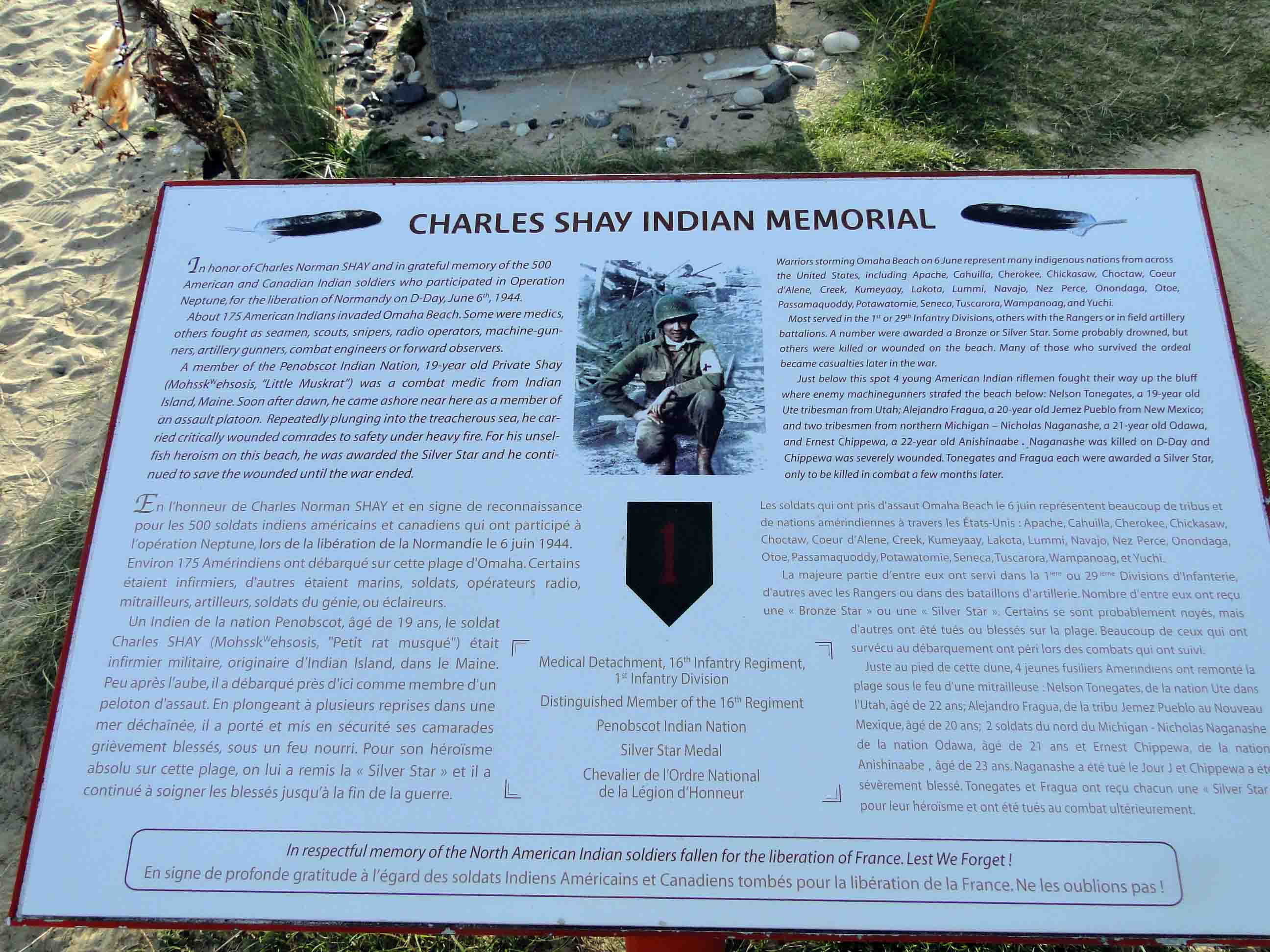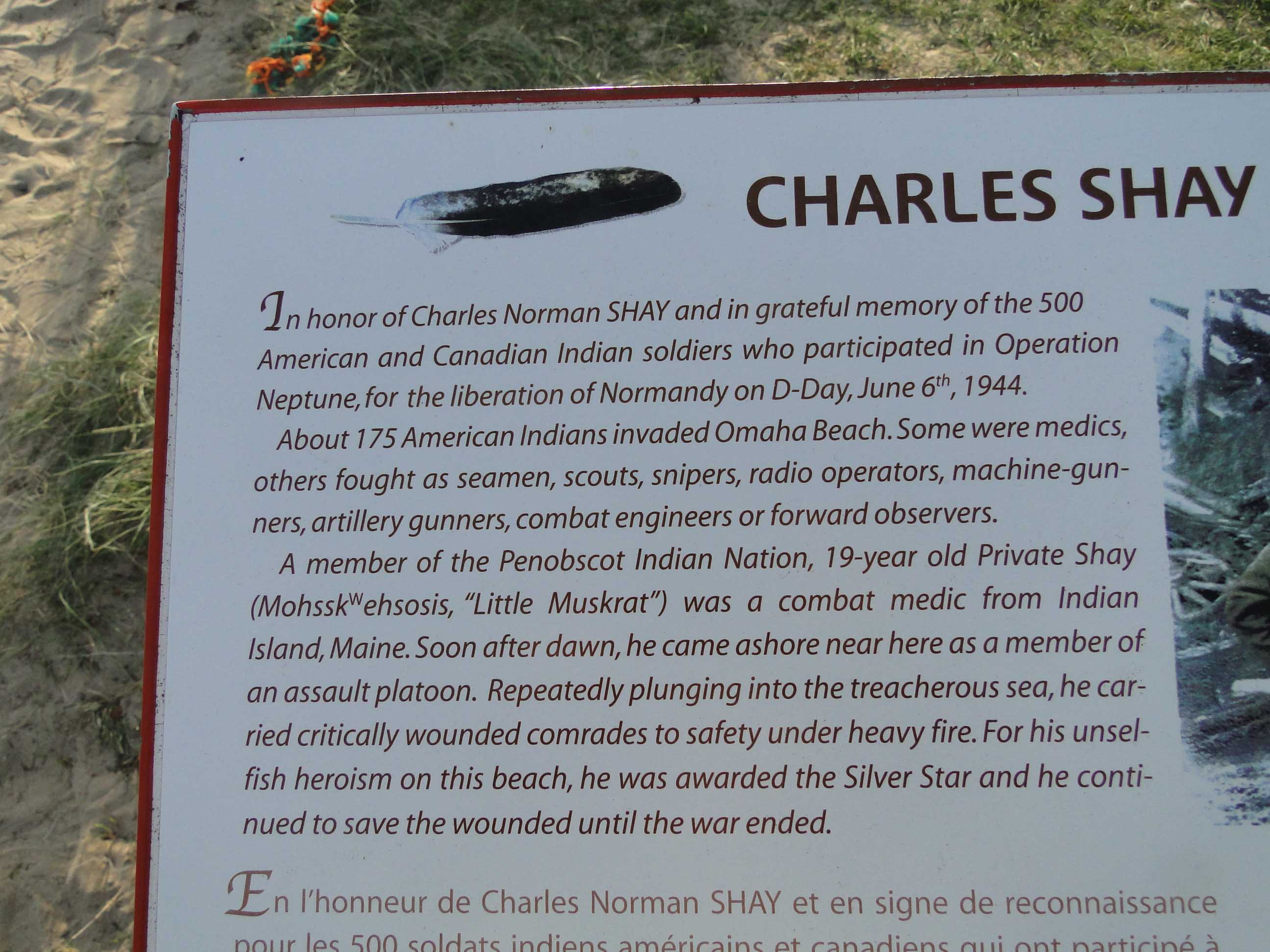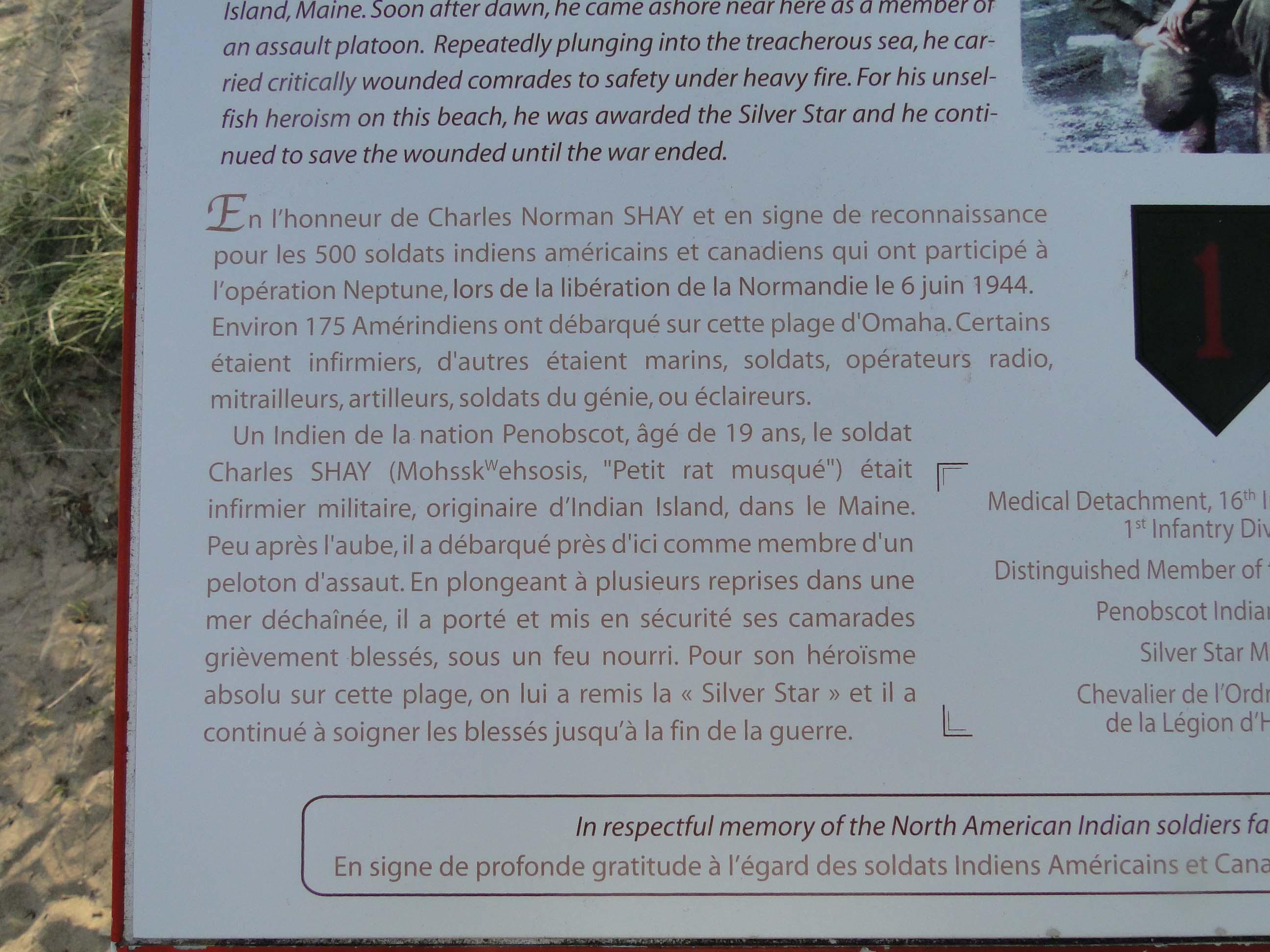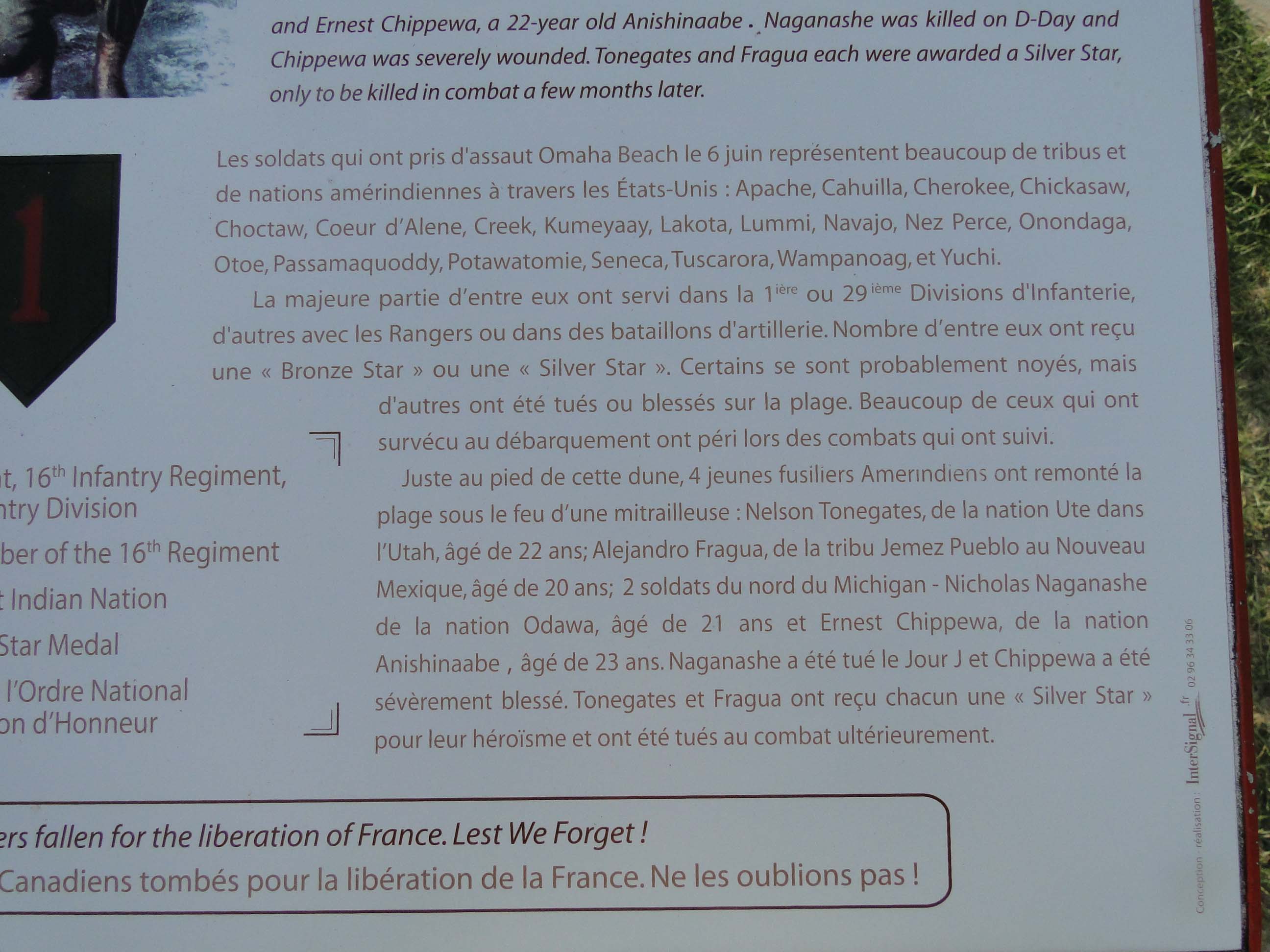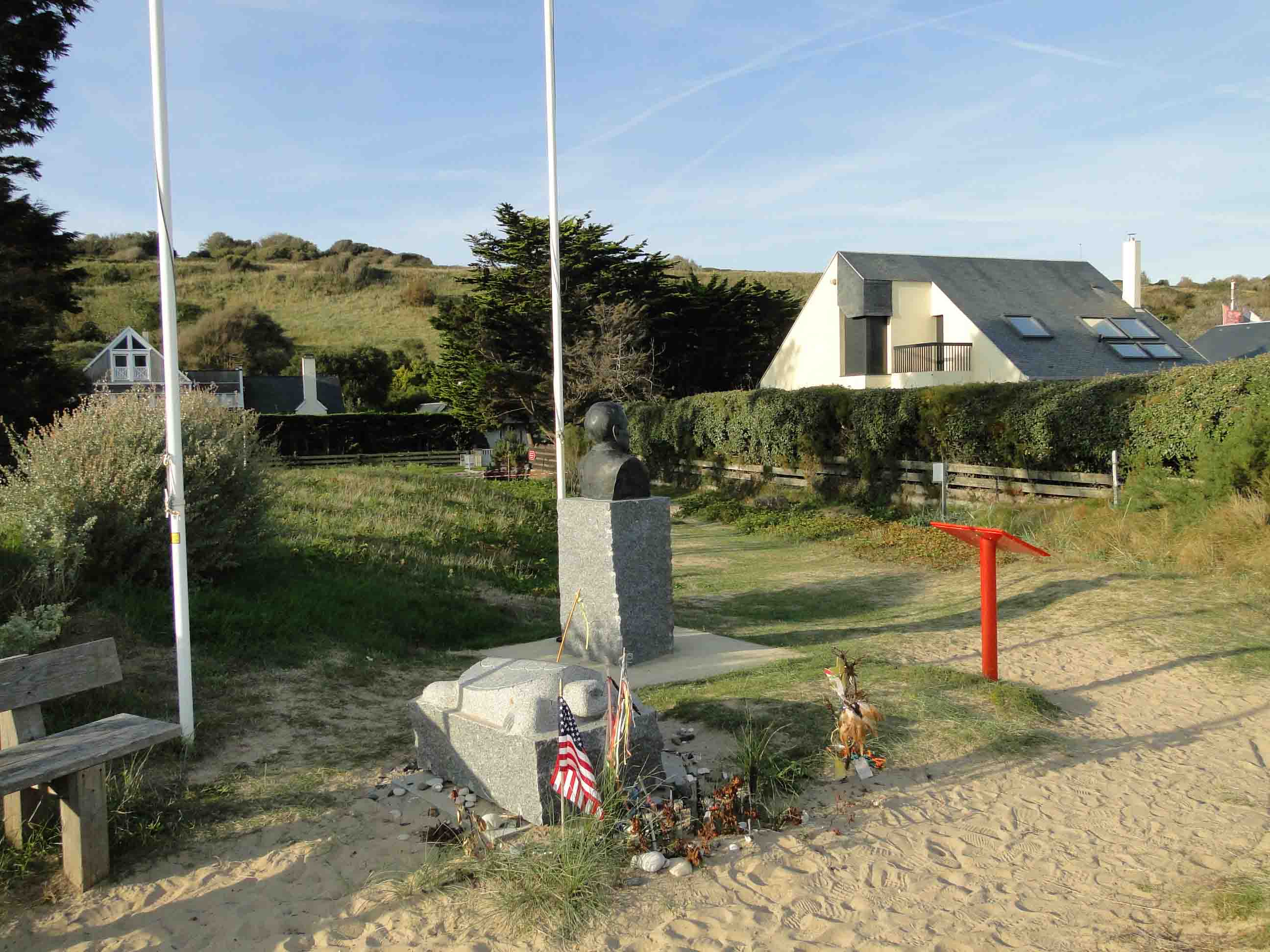Charles Shay Indian Memorial Info Sign
Details:
To the left of the bust.
A white rectangular panel that is supported by a red metal pole. The panel contains an explanation of the memorial that is written in English and French in printed letters. Also featured on the panel are the photo of Shay and the insignia of the 1st Infantry Division. Also mentioned on the info sign are the four American Indian riflemen who fought their way up the bluff where enemy machine gunners strafed the beach below.
Shay served as a combat medic during World War II and was present at the storming of the beaches of Normandy on D-Day, June 6, 1944. He is credited with saving the lives of a number of soldiers, pulling them from the sea, and saving them from drowning. He also treated fallen soldiers at the battles of Aachen, Huertgen Forest, and the Battle of the Bulge, and was held as a prisoner of war by German forces until being freed on April 12, 1945.
Monument Text:
(From left to right, English then French)
Charles Shay Indian Memorial
In honor of Charles Norman SHAY and in grateful memory of the 500 American and Canadian Indian soldiers who participated in Operation Neptune, for the liberation of Normandy on D-Day, June 6th, 7 944.
About 175 American Indians invaded Omaha Beach. Some were medics, others fought as seamen, scouts, snipers, radio operators, machine-gunners, artillery gunners, combat engineers or forward observers.
A member of the Penobscot Indian Nation, 19-year old Private Shay (Mohsskwehsosis, "Little Muskrat") was a combat medic from Indian Island, Maine. Soon after dawn, he came ashore near here as a member of an assault platoon. Repeatedly plunging into the treacherous sea, he carried critically wounded comrades to safety under heavy fire. For his unselfish heroism on this beach, he was awarded the Silver Star and he continued to save the wounded until the war ended.
Warriors storming Omaha Beach on 6 June represent many indigenous nations from across the United States, including Apache, Cahuilla, Cherokee, Chickasaw, Choctaw, Coeur, d'Alene, Creek, Kumeyaay, Lakota, Lummi, Navajo, Nez Perce, Onondaga, Otoe, Passamaquoddy, Potawatomie, Seneca, Tuscarora, Wampanoag, and Yuchi.
Most served in the 1st or 29th Infantry Divisions, others with the Rangers or in field artillery battalions. A number were awarded a Bronze or Silver Star. Some probably drowned, but others were killed or wounded on the beach. Many of those who survived the ordeal became casualties later in the war.
Just below this spot 4 young American Indian riflemen fought their way up the bluff where enemy machinegunners strafed the beach below: Nelson Tonegates, a 19-year old Ute tribesman from Utah; Alejandro Fragua, a 20-year old Jemez Pueblo from New Mexico; and two tribesmen from northern Michigan - Nicholas Naganashe, a 21-year old Odawa, and Ernest Chippewa, a 22-year old Anishinaabe . Naganashe was killed on D-Day and Chippewa was severely wounded. Tonegates and Fragua each were awarded a Silver Star, only to be killed in combat a few months later.
En l'honneur de Charles Norman SHAY et en signe de reconnaissance pour les 500 soldats indiens américains et canadiens qui ont participé à l'opération Neptune, lors de la libération de la Normandie le 6 juin 1944. Environ 175 Amérindiens ont débarqué sur cette plage d'Omaha.Certains étaient infirmiers, d'autres étaient marins, soldats, opérateurs radio, mitrailleurs, artilleurs, soldats du génie, ou éclaireurs.
Un Indien de la nation Penobscot, âgé de 19 ans, le soldat Charles SHAY (Mohsskwehsosis, "Petit rat musqué") était infirmier militaire, originaire d'Indian Island, dans le Maine. Peu après l'aube, il a débarqué près d'ici comme membre d'un peloton d'assaut. En plongeant à plusieurs reprises dans une mer déchaînée, il a porté et mis en sécurité ses camarades grièvement blessés, sous un feu nourri. Pour son héroïsme absolu sur cette plage, on lui a remis la « Silver Star » et il a continué à soigner les blessés jusqu'à la fin de la guerre.
Les soldats qui ont pris d'assaut Omaha Beach le 6 juin représentent beaucoup de tribus et de nations amérindiennes à travers les États-Unis : Apache, Cahuilla, Cherokee, Chickasaw, Choctaw, Coeur d'Alene, Creek, Kumeyaay, Lakota, Lummi, Navajo, Nez Perce, Onondaga, Otoe, Passamaquoddy, Potawatomie, Seneca,Tuscarora,Wampanoag, et Yuchi.
La majeure partie d'entre eux ont servi dans la Père ou 29 leme Divisions d'Infanterie, d'autres avec les Rangers ou dans des bataillons d'artillerie. Nombre d'entre eux ont reçu une « Bronze Star » ou une « Silver Star ». Certains se sont probablement noyés, mais d'autres ont été tués ou blessés sur la plage. Beaucoup de ceux qui ont survécu au débarquement ont péri lors des combats qui ont suivi.
Juste au pied de cette dune, 4 jeunes fusiliers Amerindiens ont remonté la plage sous le feu d'une mitrailleuse : Nelson Tonegates, de la nation Ute dans l'Utah, âgé de 22 ans; Alejandro Fragua, de la tribu Jemez Pueblo au Nouveau Mexique, âgé de 20 ans; 2 soldats du nord du Michigan - Nicholas Naganashe de la nation Odawa, âgé de 21 ans et Ernest Chippewa, de la nation Anishinaabe , âgé de 23 ans. Naganashe a été tué le Jour J et Chippewa a été sévèrement blessé. Tonegates et Fragua ont reçu chacun une « Silver Star » pour leur héroïsme et ont été tués au combat ultérieurement.
In the center:
Medical Detachment, 16th Infantry Regiment,
1st Infantry Division
Distinguished Member of the 16th Regiment
Penobscot Indian Nation
Silver Star Medal
Chevalier de l'Ordre National
de la Légion d'Honneur
On the bottom:
In respectful memory of the North American Indian soldiers fallen for the liberation of France.Lest We Forget!
En signe de profonde gratitude à l'égard des soldats Indiens Américains et Canadiens tombés pour la libération de la France.Ne les oublions pas!
Commemorates:
People:
Units:
16th Infantry Regiment, 1st Infantry Division
1st Infantry Division
29th Infantry Division
United States Army
V Corps
Wars:
WWII
Battles:
Normandy Invasion
Other images :


